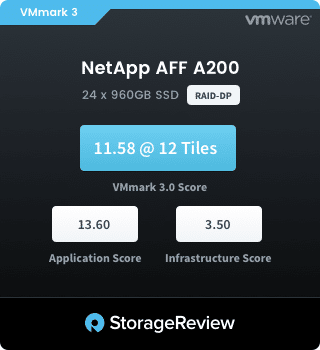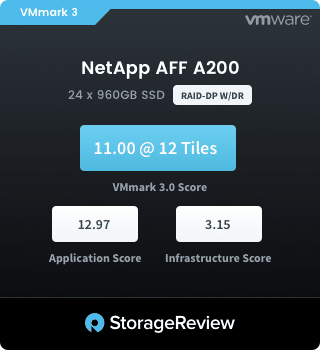
At the time of our initial NetApp AFF A200 review publishing, we were in the process of finalizing our VMmark 3 test process and working through our first submission. We’ve since streamlined the VMmark 3 submission process and our audited submissions are approved at a regular pace. The recent approvals include the results from the NetApp AFF A200. What makes these results particularly interesting is that we have data with both data reduction services enabled and disabled. For most arrays enabling these services kneecaps performance; not so with the A200.
The StorageReview VMmark 3 test environment includes 8 Dell EMC PowerEdge R740xd servers and 4 Dell EMC PowerEdge R730 servers, both equipped with Mellanox ConnectX-4 Lx 25GbE NICs or rNDCs, as well as 2 Dell EMC Networking Z9100 switches, and a Brocade 6510 16GB FC switch. The LUN configuration on the A200 consisted of eight 100GB LUNs as well as four 3TB LUNs. These were used for Deploy, SVMotion and XVMotion activities in addition to the 12 tiles themselves.

The Netapp AFF A200 was able to maintain passing scores at a load of 12 tiles operating with RAID-DP in inline compression and dedupe disabled, as well as with compression and dedupe enabled. There was a small hit in performance between these two submissions, but the key message here is the performance impact of data services was minimal. Most storage arrays aren’t able to accomplish this, with some taking a hit so large they don’t recommend users leverage data reduction in performance-oriented situations.
NetApp tells customers to run with all of their data reduction services enabled. These numbers clearly back up the claims that users won’t see a hit in performance. In a highly-virtualized environment like the one VMmark measures, the fact is, customers wouldn’t perceive there to be any difference at all, giving the A200 a strong advantage or the midmarket.
VMmark 3 Results Detail Without Data Reduction (11.58 at 12 tiles)
VMmark 3 Results Detail With Data Reduction (11.00 at 12 tiles)
Sign up for the StorageReview newsletter

